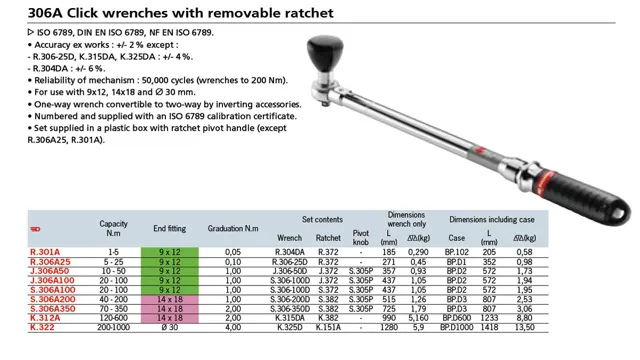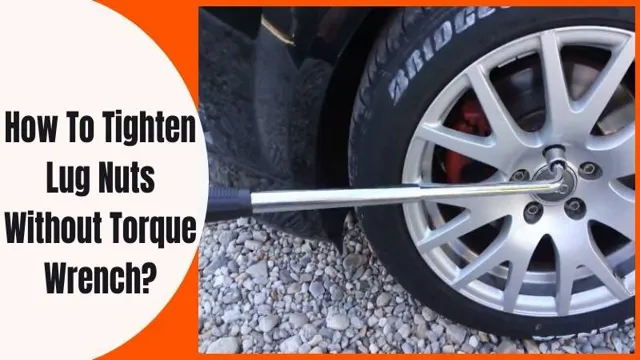How to Torque Wheels Without a Torque Wrench: Step-by-Step Guide

Have you ever been in a situation where your tire gets flat and you don’t have your trusty torque wrench with you? It can be a frustrating experience but don’t worry, there are still ways to torque your wheels without one. While it’s recommended to always use a torque wrench to ensure proper tightening of lug nuts, in some situations, such as emergencies or when you don’t have access to a torque wrench, it’s essential to know how to do it manually. One of the ways to torque wheels without a torque wrench is by using a lug wrench, also known as a tire iron.
This tool is usually found in your vehicle’s trunk and it’s designed to remove and tighten lug nuts. Another way to manually torque wheels is by using the “cross” pattern method. This method involves tightening the lug nuts in a star pattern, alternating opposite nuts until they are all tight.
This technique distributes the torque evenly and ensures proper tightening of the lug nuts. It’s important to note that, while these methods can be useful, they are not as accurate as using a torque wrench. Over-tightening or under-tightening the lug nuts can lead to safety hazards, such as the wheel falling off while driving.
So, if possible, always use a torque wrench for proper tightening of lug nuts. In summary, while it’s recommended to always use a torque wrench to torque wheels, in some situations where it’s not available, there are still ways to do it manually such as using a lug wrench or the “cross” pattern technique. However, it’s important to exercise caution and ensure proper tightening of the lug nuts to prevent safety hazards.
Why Torqueing Wheels is Important
Torqueing wheels is a crucial part of maintaining the safety and performance of your vehicle. When wheels are not torqued properly, they can become loose and cause vibrations, leading to uneven tire wear and potential accidents. While a torque wrench is the most accurate way to achieve proper torque, there are alternative methods you can use to get close to the recommended torque.
One method is using a lug wrench and tightening the lug nuts in a star pattern, evenly distributing the torque. Another option is using a torque stick, which is a tool that limits the amount of torque applied to the lug nut. It’s important to note that these methods are not as accurate as using a torque wrench, so it’s recommended to invest in one if you frequently work on your vehicle.
Properly torquing your wheels is a simple yet critical step in maintaining the safety and performance of your vehicle.
Pre-Torqueing Check
When it comes to driving a vehicle, safety should always be the top priority. And part of ensuring safety is making sure that all your vehicle’s components are secure and properly fastened. This is why it’s crucial to torque your wheels and check them regularly.
But why is torqueing wheels important? Essentially, torqueing ensures that bolts and nuts are tightened to the manufacturer’s recommended settings. This is crucial for maintaining the strength and integrity of your wheels. Without proper torqueing, you run the risk of your wheels coming loose, which can lead to accidents and damage to your vehicle.
So, before hitting the road, always make sure to do a pre-torqueing check and ensure that your wheels are securely fastened. It’s better to be safe than sorry!

Using a Lug Wrench to Tighten Lug Nuts
Torque, Lug Wrench, Tighten, Lug Nuts When it comes to changing your vehicle’s tires or doing any work on your car’s wheels, using a lug wrench to tighten lug nuts may seem like an easy task. However, it’s crucial to understand the importance of properly torquing your wheels. Torque is the twisting force used to tighten lug nuts to a specific level of tightness.
If lug nuts are not tightened to the correct torque, it can lead to a dangerous situation on the road, risking the safety of everyone in the vehicle. A lug wrench can help you complete the task, but it’s important to keep variations in lug sizes and torque specifications in mind before tightening the lug nuts. By investing in a torque wrench and learning how to use it properly, you can ensure that your wheels are tightened to the right level of tightness and avoid any potential risks on the road.
Using a Torque Stick
Using a torque stick is essential when it comes to properly torquing your wheels. Torquing the wheels on your vehicle using a torque stick helps ensure that the lug nuts are tightened to the proper specifications, preventing over or under-tightening. This is important because over-tightening can cause the studs to stretch or break, while under-tightening can cause the wheel to come loose while driving.
A torque stick is a great tool to use for this task as it will flex when it reaches the correct torque level, preventing you from overtightening the lug nuts. Remember, proper torqueing is critical to keeping you and your passengers safe on the road.
Using a Torque Adaptor on a Ratchet Wrench
Taking care of your vehicle is crucial for keeping it running smoothly and safely. One important aspect of car maintenance is making sure the wheels are properly tightened to the recommended torque specification. This is because if the lug nuts are either too loose or too tight, it can lead to issues such as uneven tire wear, reduced fuel efficiency, and even a dangerous blowout.
That’s where a torque adapter comes in handy. It allows you to accurately measure the torque applied to the lug nuts, ensuring they are tightened to the correct amount. Think of it as a doctor checking your blood pressure – without it, you can’t be sure your wheels are healthy and safe.
So next time you’re working on your wheels, remember the importance of torqueing and use a torque adapter to do it right.
Other Important Tips for Torqueing Wheels
If you don’t have a torque wrench handy, there are still ways to ensure your wheels are tightened properly. One option is to use a torque stick, a tool that acts like a limited torque wrench. Another method is to use a socket and breaker bar, but be sure to not over-tighten as this can cause damage.
A third option is to use a tightness indicator such as a torque-measuring extension or a click-type torque wrench attachment. Always be sure to check the vehicle’s manual for the proper torque specifications and follow the recommended tightening sequence. And finally, remember to check the lug nuts after driving a short distance to ensure they haven’t loosened.
With these tips, you can confidently torque your wheels without a torque wrench.
Re-Torqueing After Driving
If you’ve just had your wheels torqued, it’s important to re-torque them after driving a certain distance. This is because the heat generated by the friction of your wheels against the road can cause the bolts to loosen slightly. To maintain optimal torque, it’s recommended that you re-torque your wheels after driving for about 50-100 miles.
However, it’s important to follow the specific instructions provided by your vehicle manufacturer or mechanic as different types of wheels and bolts may require different approaches. Additionally, it’s important to ensure that you have the proper torque wrench and the correct torque specifications for your particular vehicle. Taking these extra steps can help to ensure your wheels remain securely fastened and prevent any potential accidents or damage to your vehicle.
Checking for Proper Tightness
Checking for proper tightness is an essential aspect of torqueing your wheels. However, there are other important tips that you should keep in mind to ensure the safety and longevity of your wheels. Firstly, make sure that you always use a torque wrench to tighten your lug nuts instead of relying on your own strength.
Secondly, it is crucial to follow the recommended torque settings specified by your vehicle’s manufacturer, and to check and re-torque your lug nuts after a few hundred miles of driving to compensate for any settling or loosening. Additionally, never forget to inspect your lug studs, nuts, and wheels for any damage or wear before you start the torqueing process. Another useful tip is using anti-seize to prevent any rust or corrosion from making your lug nuts difficult to remove the next time.
By following these tips, you can ensure a safe and efficient torque job that will keep your wheels securely in place.
Conclusion
In conclusion, torquing wheels without a torque wrench is a feat that requires careful consideration and attention to detail. You can do it with just a few simple tools, a bit of math, and some good old-fashioned elbow grease. But remember, torque is not just about tightening bolts.
It’s about understanding the physics of forces and knowing how to apply them. So next time you’re tempted to wing it without the right tool, think twice. Because precision and safety always trumps a hasty fix.
“
FAQs
What is torque and why is it important when tightening wheels?
Torque is the amount of force applied to a fastener to tighten it. It’s important to torque wheels to the manufacturer’s specifications to ensure proper tightness and prevent wheel damage while driving.
Can I torque wheels without a torque wrench?
Yes, you can use a torque stick or torque extension bars to achieve the correct torque without a wrench. Alternatively, you can use a calibrated torque adapter that attaches to a breaker bar or ratchet.
How do I know the correct torque for my wheels?
The correct torque is typically listed in the vehicle owner’s manual or on a placard located on the door jamb or in the glove box. You can also check with the wheel or tire manufacturer or your local mechanic for the correct specs.
Do I need to re-torque my wheels after driving for a certain distance?
Yes, it’s recommended to re-torque your wheels after driving for 50-100 miles to ensure they haven’t loosened due to settling.
What happens if I over-torque my wheels?
Over-torquing can cause damage to the wheel, stud, or nut, leading to potentially dangerous driving conditions. It can also make it difficult to remove the wheel in the future.
Can I torque my wheels while the car is on a jack?
No, it’s important to torque your wheels with the car on the ground to ensure the correct torque is applied to the wheel.
What if I don’t have the correct torque specs for my wheels?
In this case, it’s best to consult with a professional mechanic who can help you determine the correct torque specs for your wheels and ensure they are properly tightened.



